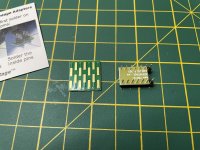So the little Musical Fidelity A220 got a bit of an upgrade. A perfect way to destress after work, when I have more time I will do some measurements but for now I'm listening through a little pair of CH50s and at the weekend I'll have the Castle Harlechs (1/4 wave) out and have propper listen.
The alternative motive for this is to practice SMT soldering for another project.
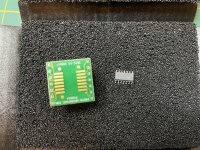
That's small (and that's through the 2x lense light.. not as small as the 0402 or the LT4032s that came for a different project..
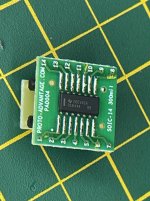
I thought the soldering was quite simple (the pins also needed soldering.
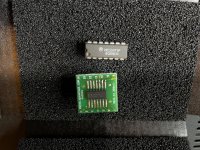
Aww..
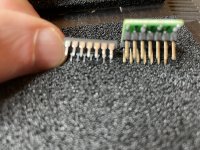
Doh.. poop. the pin thicknesses on the adaptor kit will not fit the A220 DIP14 socket. So with some 600 grit wet/dry sandpaper.. you guessed it.. the pins fit in the old socket 😀
So after the initial power up on some 8R 100W resistors to check it's all ok, it's on to some speakers for a listen. It didn't go bang.. which is good because I note that Mouser have zero stock since I ordered last week! (I triple checked pin1!).
So it takes the A220 about an hour to reach it's equilibrium with the old MC33079P and the new OPA1644A is no different. Once it's reached it's equilibrium. The key seems to be the output devices / VAS stage like being at a certain temperature.
Initial impressions when cold are snatches of more detail but no musicality. However now the amp has warmed up it seems to show detail in complex pieces whilst retaining musicality without seeming being tiring. Phew. It still needs more listening but so far it seems like a keeper.
The A220 got repaired with new caps, new rectifier, and I thought I may make this change back then so used Panasonic hybrid caps to give a 5mOhm ESR preamp power supply. I don't know at this stage if the preamp power changes really makes a difference but the OPA1644A is a pin-compatible replacement (once mounted on the adaptor) that seems to make a decent step in clarity.
When I have some time I will do some tests to compare the two chips.
The alternative motive for this is to practice SMT soldering for another project.

That's small (and that's through the 2x lense light.. not as small as the 0402 or the LT4032s that came for a different project..

I thought the soldering was quite simple (the pins also needed soldering.

Aww..

Doh.. poop. the pin thicknesses on the adaptor kit will not fit the A220 DIP14 socket. So with some 600 grit wet/dry sandpaper.. you guessed it.. the pins fit in the old socket 😀
So after the initial power up on some 8R 100W resistors to check it's all ok, it's on to some speakers for a listen. It didn't go bang.. which is good because I note that Mouser have zero stock since I ordered last week! (I triple checked pin1!).
So it takes the A220 about an hour to reach it's equilibrium with the old MC33079P and the new OPA1644A is no different. Once it's reached it's equilibrium. The key seems to be the output devices / VAS stage like being at a certain temperature.
Initial impressions when cold are snatches of more detail but no musicality. However now the amp has warmed up it seems to show detail in complex pieces whilst retaining musicality without seeming being tiring. Phew. It still needs more listening but so far it seems like a keeper.
The A220 got repaired with new caps, new rectifier, and I thought I may make this change back then so used Panasonic hybrid caps to give a 5mOhm ESR preamp power supply. I don't know at this stage if the preamp power changes really makes a difference but the OPA1644A is a pin-compatible replacement (once mounted on the adaptor) that seems to make a decent step in clarity.
When I have some time I will do some tests to compare the two chips.
Attachments
I finally got around to listening to this last night on the big speakers with a quiet house after I'd also added some decoupling ceramic caps from Vrails to ground.
Measurements - this appears to have the same frequency response with an 8R load.
Listening - small speakers, more detail but the ceramic decoupling cap removes some harsh noise which I believe is down to a little instability. Only issue is it sounds "dead"/lifeless in comparison lacking in bass a little.
Listening - larger floor standers, detail goes right down and it seems the bass goes right down, perhaps the opamp current output is allowing better base replication. It sounds deeper and cleaner than the older configuration, like there's a gap where the old bass used to be. It changes the sound on alot of mixes. I don't know if it's good or bad.. other than there appears to be more detail around instruments (Tool - the base you can hear the sound of strings).
Will have a second listen tonight.
Measurements - this appears to have the same frequency response with an 8R load.
Listening - small speakers, more detail but the ceramic decoupling cap removes some harsh noise which I believe is down to a little instability. Only issue is it sounds "dead"/lifeless in comparison lacking in bass a little.
Listening - larger floor standers, detail goes right down and it seems the bass goes right down, perhaps the opamp current output is allowing better base replication. It sounds deeper and cleaner than the older configuration, like there's a gap where the old bass used to be. It changes the sound on alot of mixes. I don't know if it's good or bad.. other than there appears to be more detail around instruments (Tool - the base you can hear the sound of strings).
Will have a second listen tonight.
For sockets you need pin headers with round pins. Such as this:
https://www.partco.fi/en/connectors/pin-header-connectors/pin-headers-r254/1630-pr-1x20-uu.html
https://www.partco.fi/en/connectors/pin-header-connectors/pin-headers-r254/1630-pr-1x20-uu.html
